|
July
22
We heard hyenas in the night, and
the ascending whistling notes of a pearl-spotted owlet calling
early in the morning. Since it was moving day, it would be an
all-day drive with the luggage trailer in tow. We had our usual
quick breakfast of toast and jungle oats, and headed out at 6:30.
Parker, Phillimon and
Pula would pack up camp, drive to the Khwai Concession and set our
next campsite; we would meet them there in the evening.
Gee
stopped the Landcruiser at a spot where we could see a large round
hill in the distance, and we watched the sun come up from behind
it. The sky turned to scarlet, and then we could see the rim of
the sun just barely peaking up over the top of the hill, with the
trees silhouetted against it. Birds flew across the crimson sky as
the fiery orb slipped above the horizon. This was sun-uppers at
its best.
Two spotted hyenas went loping past, barely seen in the
early dawn light, intent on some private destination. We went by
the waterhole pans but nobody was there. We paused to watch two
tree squirrels sitting on the trunk of a large tree; they looked
very similar to our squirrels at home.
We came across two lionesses beside the road. One was
sleeping, and the other was sitting gazing intently out over the
bushveld with a slightly wistful expression. As we drove up close
she turned and looked at us briefly, then resumed watching the
plain. We studied her from close quarters; she was exquisite.
After a while she stood up and posed for us in the morning light,
still looking out into the distance. Her body was strong and
muscular yet lean; a perfect hunting machine. She was all
magnificent power and dangerous beauty. Eventually she lay back
down, but she still kept a restless eye on everything around her.
Gee drove us back to Leopard Rock to check on the mother
leopard and her cub. Mama was home; we could see her spots through
the den opening. She was grooming herself and licking the baby. We
watched her a long time, using binoculars to see into the dim
cave. The leopardess stood up and turned around restlessly a
couple of times, looking out of the opening.
Gee knew the leopardess was going to come out. “Look –
watch - get ready,” he told us, and we waited silently, holding
our breaths. And sure enough, she stood up and came out of the
cave. She quietly slipped through the trees and tall grass, making
her way across the outcroppings and up the steep slope. Her
spotted coat glowed softly in the morning light. She had an
exquisite, feminine face – could this be the same leopardess we
saw near here two years ago? She moved with a silken grace, easy
and athletic, as if gravity did not affect her. She climbed higher
up the ridge, pausing now and then to look around regally, giving
us superb photo ops.
Finally
the leopardess came out on the top of a big rock outcropping and
paused, looking out across the land, surveying her territory. If
Disney was making a movie entitled The Leopard Queen and she was the star, this is just where they
would have her stand. She was regal - the queen of all she sees.
After a while she lay down on the point of the rock and gazed out
across the plain. She seemed content to relax and enjoy the
sunshine. “My God,” Gee breathed quietly. “This is amazing!
You never see it like
this.”
|
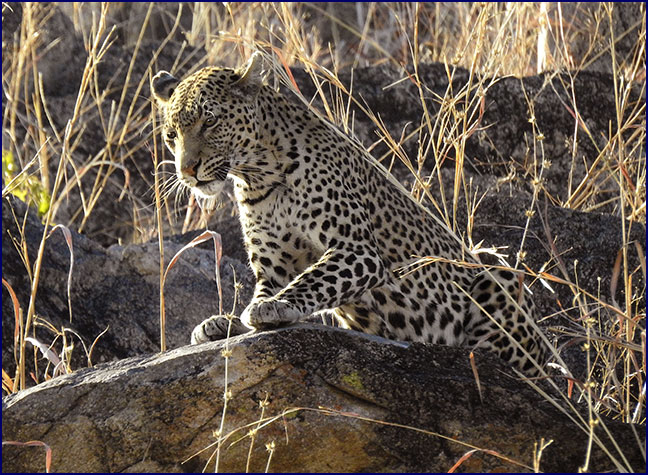
The
Leopard Queen |
After a while the leopard queen stood and climbed higher.
She was silhouetted against the sky as she traversed the ridge,
backlit by the bright morning sun, with tall golden grasses
blowing in front of her. This was magic. Gee repositioned the Land
cruiser to keep her in view. She sat for a while at the top of the
cliff, and then crossed over the top of the ridge and disappeared
from sight.
We drove around to the other side of Leopard Rock; the road
was further away, but it gave us a good view of the entire ridge.
We could see the leopardess, tiny against the huge cliff, moving
sinuously among the rocks. Gee said she might be checking out the
caves, making a plan in case she needed to move the baby. She
rubbed her jowl against the rocks, leaving
her scent to mark her passing. She finally disappeared behind some
dense bushes, so it was time to move on. What a spectacular
sighting it had been! Patty
dubbed it The Lady Leopard
of the Rocks Show. Gee’s talisman must have been at
least partially responsible.
A herd of wildebeests walked slowly across the plain in a
long single file row, parallel to the road. We stopped to look at
some elephant tracks in the dusty road; there were some prints
from a baby that were barely bigger than my hand.
We stopped at a stretch point for
tea break, not far from the lions’ waterhole. It was a rather
barren place with one lone tree, not the prettiest of spots.
A lilac-breasted roller was perched on the top of a sparse
bush; I had my camera ready, and got another crack at in-flight
shots when he took off.
There were no elephants at tea break today, but a little
squirrel came down out of the lone tree to beg for crumbs. There
were no bushes so we had to go behind a termite hill to check the
tires. Walking back to the vehicle, something made me look down at
the ground, and I found a great prize - an elephant tail hair!
Obviously the spirit of the elephants was with us at tea after
all, even if we couldn’t see them.
Driving on after tea, we soon came upon a pair of ostriches
strutting along near the road. This was the closest we had gotten
to a female; her grey-brown feathers were puffed up and she looked
quite stylish. She was eating, and her neck and throat would
expand like a python when she swallowed. Her expression seemed a
bit frivolous, but with her tiny head compared to the size of her
neck and body, one did not expect a lot of brain power.
We set off through the mopane woodland. A handsome Senegal
coucal sat on a twig; a large bird with bold black, white and
copper coloring. We could see a white-headed vulture soaring
overhead.
There were four bull elephants
among the trees, and two of them were very close to the road. We
stopped to watch them feed. One of them approached the vehicle and
looked at us closely, raising and lowering his trunk like he was
smelling us. After a while he must have decided we were OK and he
went back to eating. He would pull up a big clump of grass with
his trunk, whirl it around in circles and bang it on his leg to
knock the dirt off the roots, and then put it in his mouth to
chew. We watched it all from about five feet away. Gee explained
that elephants have six sets of teeth through their lifetime, and
when they wear out the sixth set then they starve.
We were heading for our next camp, which would be in the
Khwai Concession. We had a long drive ahead of us along the edge
of the Mababe Depression, a vast open plain that sometimes floods
in the rainy season, depending on how much water flows from the
Savuti channel. This is dictated partly by the rainfall, but even
more so by the shifting of the tectonic plates; there are areas of
marshland that have changed to desert for several decades, and
then back to marsh again
|
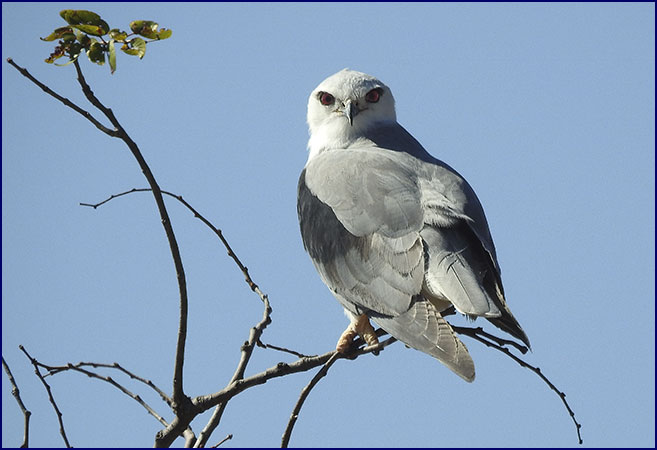
Black-shouldered
kite |
We took a deep sandy road through a forest of stunted,
elephant-eaten mopane trees, right beside the edge of the plain.
For the next hour and a half we didn’t see a lot of animals, but
there was a fabulous variety of birds, including a number of ones
we had not yet seen. A black-shouldered kite looked at us from a
lofty perch before sailing away; this smallish bird of prey has a
rounded head and looks slightly owl-like. A swallow-tailed
bee-eater perched on a twig; he had a bright blue collar and a
long forked tail. Many trees had buffalo weaver nests hanging from
the limbs, and Gee pointed out several of the weaver birds in the
bushes. We saw a purple roller, less common and not nearly as
pretty as his lilac-breasted cousins.
|
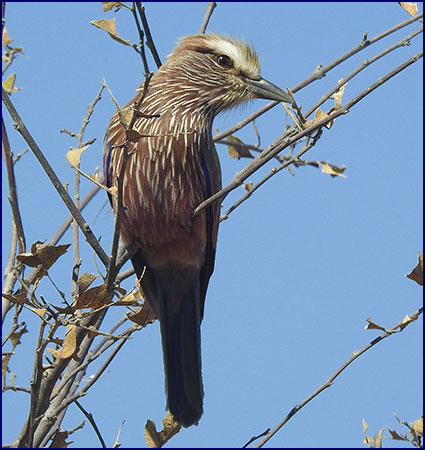
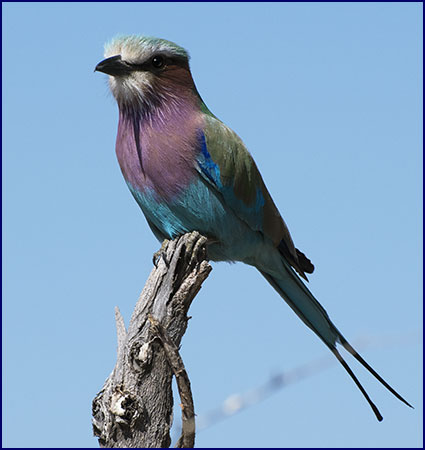
The
purple roller versus the lilac-breasted roller. |
Other birds we saw were old friends: A greater blue-eared
starling gleamed in the sunlight, a brilliant deep blue color. A
lilac-breasted roller had a choice perch in a tree, only to be
chased away by a red-billed hornbill who wanted to sit there. We
got a good close view of a pert little black fork-tailed drongo.
Shortly after noon we came out of
the woods onto the open plain of the Mababe Depression. We stopped
and had lunch under a shepherd’s tree, an evergreen with a
distinctive whitish trunk. It had been our lunch spot on the
previous trip as well; no tsessebes this time. There was one other
Letaka Safari vehicle there, and we met the guide, who was
Phillimon’s father. We spent a leisurely hour sitting in the
shade before resuming our journey.
On our way again, we rolled along the edge of a vast
treeless plain. We saw a warthog on our right, the first animal
for a long time, then a giraffe on the left, and then more
warthogs on both sides. Soon we were seeing impala, zebras, and
dozens of giraffes, mostly taking advantage of the shade under the
few trees along the edge of the plain.
A family of warthogs ran along near the road, their tails
held straight up over their backs. Soon they slowed down and
started to graze, walking on their knees to reach the grass
easier. There was one poor fellow who was missing an ear. Warthogs
are ridiculous looking creatures, with sparse hair and large
snouts. They have bony protuberances on their cheeks that give
them their name, up-curving tusks, and stiff bristly white
mustaches. We dubbed the area Warthog Alley, because they were
everywhere.
A tawny eagle stood sentinel on the top of a tall tree. We
saw white-browed sparrow weavers, a juvenile African hawk eagle
and a fabulous blue long-tailed Meves’s starling. There were
several red-billed teals in a small waterhole, attractive little
duck-like birds. A secretary bird took flight, skimming along just
a foot above the grass somewhat awkwardly. Somehow he reminded me
a little of the roadrunner from the cartoons.
|
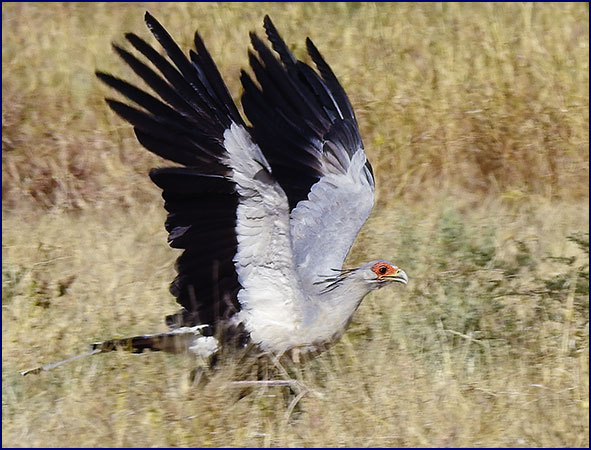
Secretary
bird |
Suddenly three huge bull elephants appeared on our right,
walking quickly with silent tread, seemingly on a mission. It is
truly amazing how silently these giants can move; though they were
just twenty meters from us, we could not hear a sound. A pair of
tsessebe stood near the road, their purplish-brown coats caked
with mud. Then a family of muddy wet warthogs went running across
in front of us, jumping fallen trees and logs like they were going
cross-country.
|
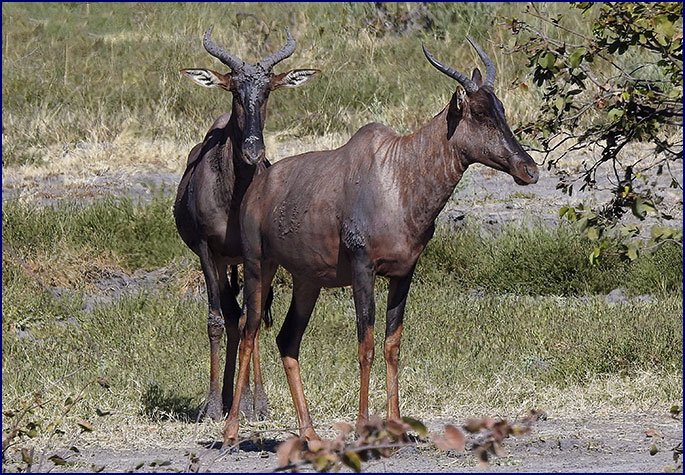
Tsessebes |
We came to the Mababe Gate, leaving Chobe National Park
behind. While Gee took care of the paperwork we studied the maps
at the gate, curious to visualize where we were going. A very old
looking hornbill with a damaged beak sat on a bleached giraffe
skull by the gate, looking up at us haughtily.
For the next ten kilometers we
drove on the main gravel road, which was dusty and very
wash-boarded. There were eerie dead trees alongside the road, with
bare twisted branches like reaching hands. Everything was covered
in a fine white dust; the road, the trees and shrubs, and us. We
noticed a triangular caution sign with a large leaping antelope on
it; the international symbol for a kudu crossing.
|
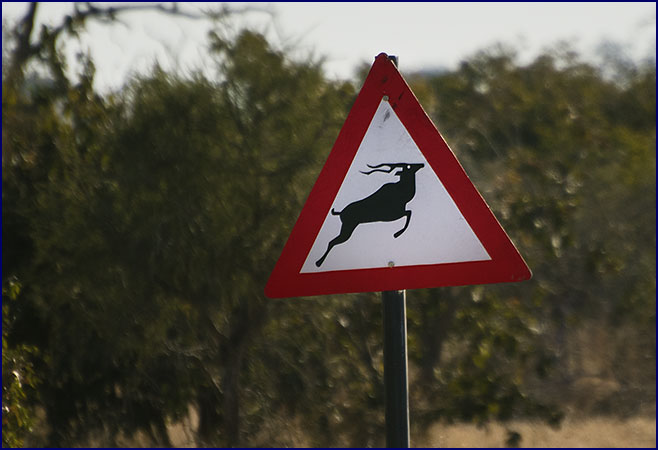
Kudu Crossing |
There was a tiny steenbok by the road, very delicate and
beautiful, with short spike horns. He was covered in flies; there
must have been hundreds of them on his face and back. A bit
further on Gee heard a loud bird call and stopped; he spotted a
red-crested korhaan in breeding plumage. He had a rusty-red crest
that looked like a mane accenting his variegated brown, black and
white color.
|
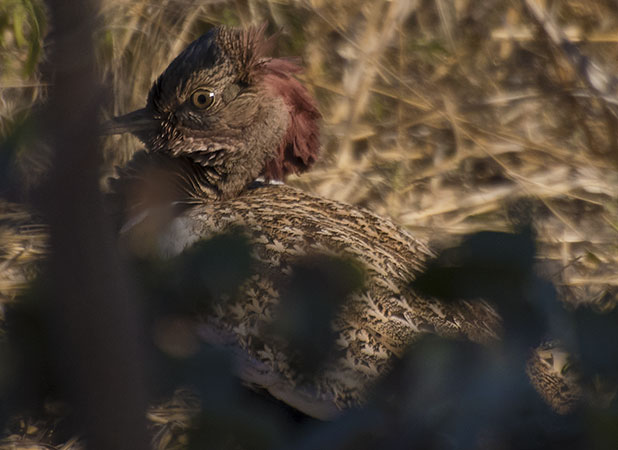
Red-crested
korhaan |
We turned off the main road and drove down a smaller lane;
Chobe was on our left and the Khwai Concession on our right. Soon
we came to the Khwai Gate. It was well into the afternoon but we
were in no hurry; we couldn’t arrive at our new camp before six
o'clock, because the guys needed time to have it set up.
The landscape began to change dramatically; we were at the
edge of the Okavango Delta, which flooded annually with waters
from the rains in Angola a thousand miles to the north. There were
rivers, channels, lakes and lagoons everywhere, and the area was
much more lush and green than the dry plains of Savuti. Because
the flooding of the Delta coincides with the dry season, there is
a high concentration of wildlife around the Delta at this time of
year, much of it different from what we saw in Savuti.
We came across three waterbucks. Larger than an impala but
smaller than a kudu, these attractive antelopes have thick soft
brown coats, white markings on their faces, and a white ring on
their rumps like a big target. The males have long curved spiral
horns.
Tara was on the lookout for
crocodiles; twice she thought she saw one, but both times it
turned out to be a floating island of weeds or debris moving with
the current. A pair of massive kudu bulls walked along the far
side of a river channel, the late afternoon light illuminating the
shaggy manes below their necks and their marvelous twisting horns.
|
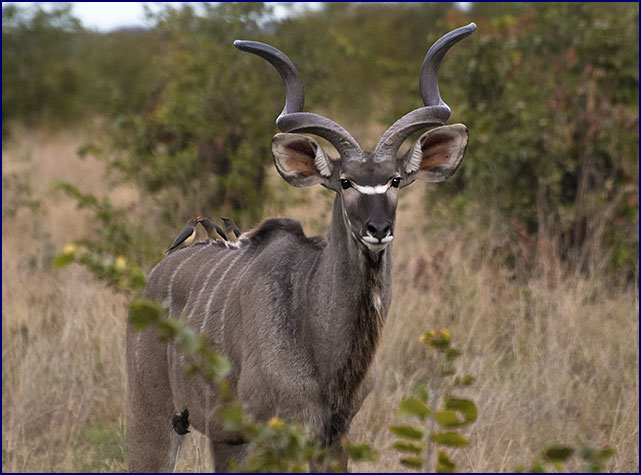
Kudu bull |
Suddenly the air was filled with a high-pitched haunting cry; it
was the call of a fish eagle. He was sitting high in a tree,
looking down over the river. Dark brown or black in color, the
fish eagle has a white head and neck, and looks quite similar to
our American bald eagle.
|

Fish
eagle |
A spur-winged goose stood by the edge of a small channel;
he stretched his wings wide and flapped them, showing off an
impressive wingspan. At first glance his plumage was a bold black
and white, but in the sunlight his back shone with highlights of
green and purple. A sacred ibis perched in a dead tree, a large
bird with striking black and white plumage and a long curved bill.
We were driving along beside a narrow
river when Tara sighted our first Nile crocodile sleeping on the
far shore. It was a big croc with a clean-looking brown and green
color, still wet from a recent swim.
|
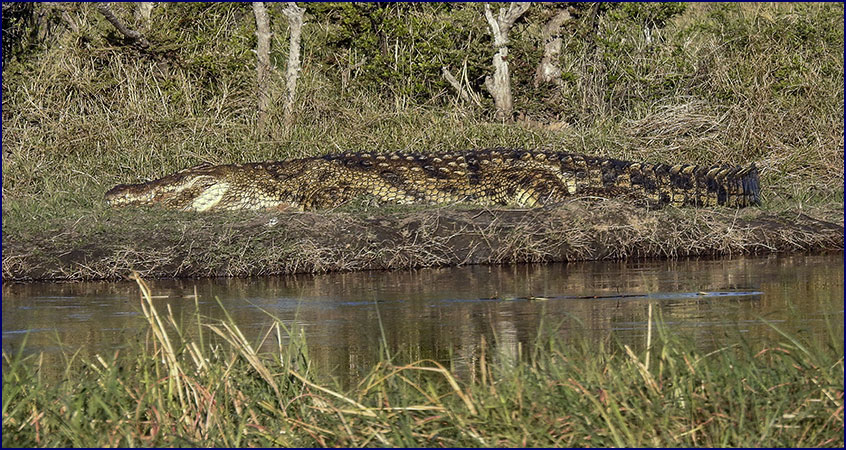
Nile crocodile |
Before long we came to a small lagoon where several hippos
floated, only the tops of their heads and backs visible above the
water. These were the first hippos we had seen since the hippo
rock in the waterhole at Savuti.
Three bull elephants were moseying along near the road;
they made their way to a marshy channel and stood contentedly in
the shallow water eating the tall grass.
A small group of vervet monkeys were climbing in a tree.
They moved up and down the trunk and through the branches
effortlessly on lithe graceful limbs. The dominant male made a
striking image as he stood on a limb gazing out, silhouetted
against the sky; he had a grey-brown coat with black face, hands
and feet, and his balls were a bright powder-blue.
|
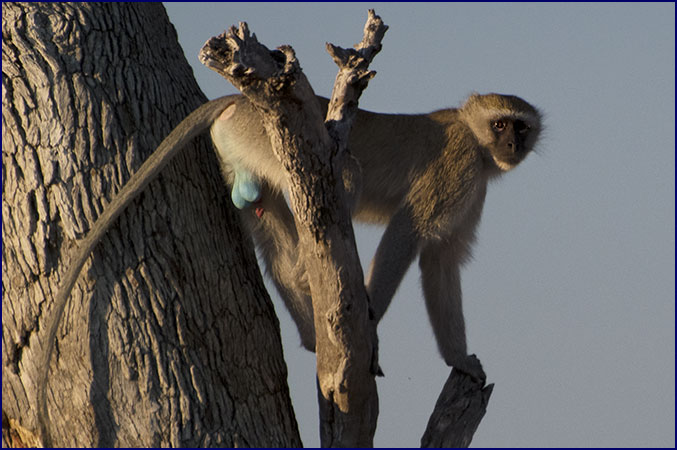
Vervet monkey |
The sun was lowering toward the horizon, and we watched
through the acacia trees as the sky turned orange. A female kudu
stood beneath the trees, less massive and powerful than the males
but with a graceful beauty that is hard to top. Then Gee got the
radio call – the wild dogs were on the hunt!
Gee set off driving fast toward the area where the dogs had
been sighted. He had to brake hard at one intersection; a huge
bull elephant was getting ready to cross, and though the elephant
was polite he was not about to give up his right-of-way.
We skirted through sparsely wooded
areas and across open meadows, looking for the African wild dogs.
Lean as greyhounds, they can run fast for great distances. They
live and hunt in packs, and have a very high success rate when
hunting. The dogs have patchwork coats of black, white and tan, an
imposing set of teeth, and large round ears. They are also known
as painted dogs or African
hunting dogs.
|
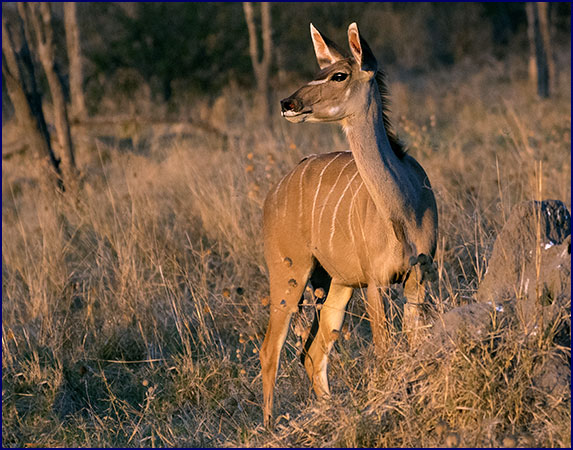
A kudu doe,
alarmed by the hunting dogs. |
Gee watched the antelopes to get clues to the whereabouts
of the dogs; the impala and kudus were snorting in alarm. The
zebras wore not worried - the hunting dogs rarely go after
something that large, preferring impalas and other smaller
antelopes. Gee tried to determine the direction they were moving
and get ahead of them.
Suddenly a dog with a
light-colored coat came by us, running hard on the hunt, zig
zagging back and forth and leaping over logs. Another followed,
this one darker in color and a little further away. Gee had
positioned us perfectly and the dogs gave us a great show, running
intently, following the trail of their prey.
|
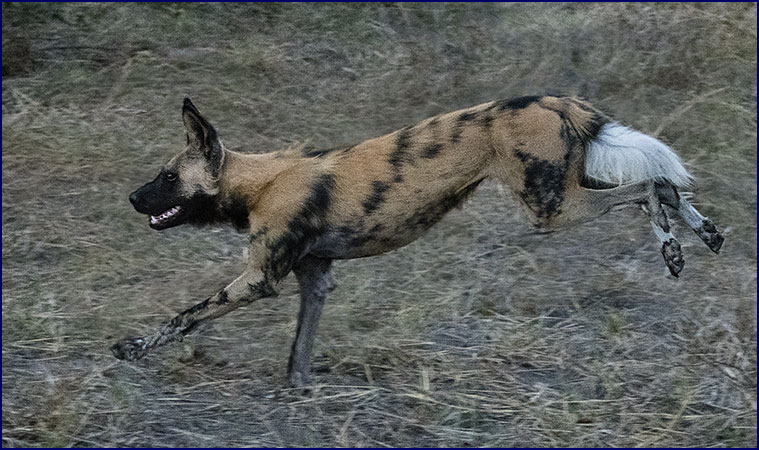
African
wild dog |
We followed the dogs, trying to keep them in sight. Gee had
a great knack for anticipating which way they would go and getting
us to where we could see them, but the light was fading fast and
after a while we lost them. The zebras were standing quiet against
a pastel sky and some kudus huddled nervously in the brush – but
the impalas were nowhere to be seen - they had taken off running
for their lives. Gee drove us out by the river, where we watched
the last vestiges of a brilliant sunset. Dark trees stood in
contrast against the blazing colors reflected in the water.
As we lingered there in the
gathering darkness, two dogs came out of the brush and trotted
down to the edge of the water, crossing right in front of us. They
stood there silhouetted against the river for several long
moments, then turned and disappeared back into the brush.
“Amazing,” Gee proclaimed, using his signature phrase.
“Unbelievable.”
It was quite dark by now, and we were still quite a ways
from our camp. Even though Khwai allows night driving and there
was no curfew, we had spent a long day traveling and were getting
tired - but I was still loving every minute of it. Driving along
beside a watercourse, when the vehicle paused we could hear a
noise like a thousand crickets; Gee explained the sound was made
by a flock of tiny birds called red-billed queleas.
It was well after six o'clock so
we thought we would be in camp soon; the guys would have it set up
and ready by now. But Gee told us that our camp was in a remote
area not normally used for camping, and it would take a while to
get there. Then instead of heading straight for the camp, Gee
turned on the spotlight, sweeping it back and forth across the
road in front of him as he drove, looking for night animals.
Almost right away we came across a
leopardess, hunting in the night. We followed her, tracking her
movements with the spotlight, but Gee was careful not to shine the
light in her eyes or disturb her hunt. After a few minutes she
moved off of the road and disappeared into the darkness. Gee told
us that the leopard is his favorite animal. I was beginning to
think it might be mine as well.
A bit further on, Gee shone the light on a scrub hare; the
little rabbit was huddled in the grass looking vulnerable. Not
high on anybody’s list of which African animal they would like
to be, especially with the hungry leopard nearby.
And then we found springhares!
These little miniature kangaroos are one of my favorite nocturnal
animals. They are technically rodents, not kangaroos; kind of a
cross between a rabbit and a rat, but they sit up on powerful
(relatively speaking) hindquarters and hold their little front
paws up in front of their chests, and hop like tiny kangaroos. I
am completely in awe of the fact that Africa has tiny kangaroos,
and nobody even knows about them!
|
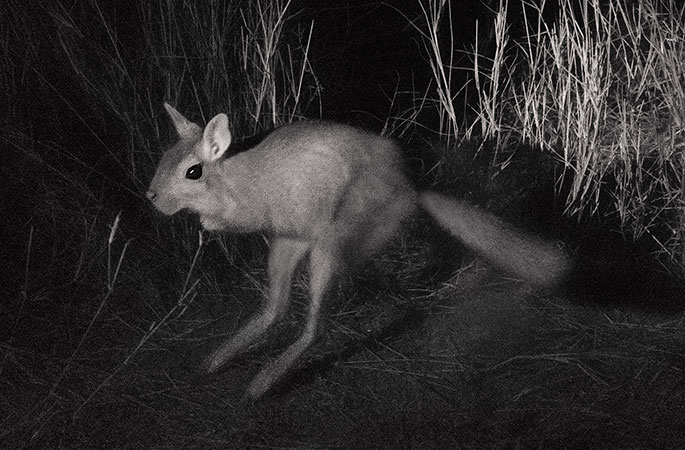
Springhare! |
We turned down a tiny narrow road and crossed several water
channels, each deeper than the last. After all, we were in the
Okavango Delta, famous for its seasonal flooding. Finally we came
to a crossing that was deeper than the others; Gee instructed us
to pick up our belongings off the floor to keep them dry. As the
Landcruiser plunged into water that came halfway up over the hood,
we were starting to see why the vehicle was equipped with a
snorkel. Patty expressed dismay as the water sloshed up through
the floorboards onto our feet, as well as high up the sides of our
luggage trailer. “Welcome to the Delta!” Gee turned and said
with a wolfish grin.
It was quite late by now. Though we were having a great
time, we had been driving for nearly 14 hours, and we were tired.
We were in a totally remote area – we had seen no other signs of
vehicles or people for hours, and had no idea how far from camp we
were. Suddenly Gee stopped the Landcruiser, killed the engine, and
turned and looked at us. “I am totally lost,” he said, “I
have no idea where we are.” Having gone on safari with him
before I knew he was teasing us, but some others fell for it in
dismay. Gee chuckled and started up the Landcruiser, and within
five minutes we were in camp.
It was almost eight o'clock when we arrived, and very dark.
It turned out that our camp really was remote; it looked like
nobody had been there in ages. We couldn’t see it very well in
the dark, but we could make out a large body of water right by the
dining tent. Somehow the camp seemed only about half put together;
there were only a few lanterns out, and the paths to our tents
were very rough – we had to climb over roots and branches to get
to them.
In our tent, Jineen and I found
that our twin beds were awkwardly placed, necessitating a bit of
rearranging. However the slope of the tent floor limited the
options, and after collapsing the bed several times we ended up
putting everything right back where it had been when we started.
Opening my suitcase, I found that my clothes were quite wet from
that last water crossing. But no worries; we strung up a
clothesline in the shower enclosure and hung them all out to dry.
We made our way back out to
the fire, tripping over logs on the unused path. Sitting around
the campfire we could hear loud splashing - there were elephants
in the river just down from camp. Hippos were calling nearby,
their voices sounding like slightly sinister laughter. There was a
constant chorus from the frogs, occasionally accompanied by some
night bird. We looked forward to seeing what the camp looked like
in the daylight.
Dinner was excellent as usual. We learned that Pula,
Phillimon and Parker had gotten lost on the way and couldn’t
find the camp; they had arrived only three hours before us. No
wonder the camp wasn’t quite finished! This explained why Gee
had gotten us here so late; he had been in radio contact with them
and knew that the camp was not ready, so he had stalled for time
by taking us night driving. The guys had done a spectacular job
putting it all together in such a short time. We thought we
were tired, and all we had to do was ride in the Landcruiser and
look at animals. But those guys had to pack up the old camp, drive
to the new locations, set up the camp and have our dinner ready
for us when we arrived! They are amazing.
At dinner we asked Gee if this
campsite had been used much; he said that actually this was the
first time it had ever
been used for camping! Being repeat customers, Letaka wanted to
make sure we had a private camp in an uncrowded area. The best two
regular sites were already taken, so they opened this new area
just for us, and we were the first people to camp here. No wonder
it wasn’t perfectly prepared yet. We loved the privacy and the
newness of it.
So far this trip had been special, and we had already seen
a fantastic variety of wildlife. Lions close-up, a baby leopard,
elephant spas and wild dogs hunting, among many others. There were
only a few things left on the wish list. Rob was really hoping for
an aardvark, and Paula (and Fred) dreamed of seeing a bushbaby. I
had always wanted to see a honey badger, but I knew that
wouldn’t happen so I didn’t want to mention it.
We were all tired, and soon headed
for bed. There would be little enough rest for the crew, who had
to be up long before our 5:30 wakeup call. Back in our tent,
Jineen and I found that something had eaten our toilet paper while
we were at dinner. Definitely something bigger than a mouse. A
squirrel maybe? No, they are not nocturnal. Perhaps a genet?
I climbed into my bed, gratefully
snuggling with the hot water bottle that had been placed under the
covers. All I can tell you is, if anyone ever offers to put a bushbaby in your bed, do
not turn it down! It is
one of the finer experiences in life.
|